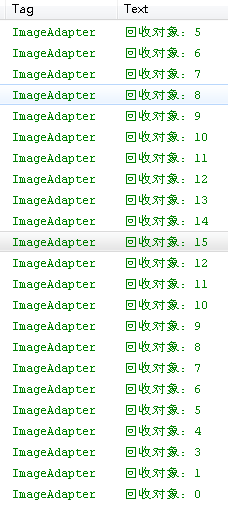3DGallery内存优化-可以装载大量图片
问题:如果加载的图片过多,会导致OOM溢出 |
| 分析:这是由于一次性大量将图片加载到内存,会导致内部不足,Out Of Memory异常。 |
| 解决:可以通过软引用、弱引用来解决 软引用:如果一个对象只具有软引用,那就类似于可有可物的生活用品。如果内存空间足够,垃圾回收器就不会回收它,如果内存空间不足了,就会回收这些对象的内存。只 要垃圾回收器没有回收它,该对象就可以被程序使用。软引用可用来实现内存敏感的高速缓存。 软引用可以和一个引用队列(ReferenceQueue)联 合使用,如果软引用所引用的对象被垃圾回收,Java虚拟机就会把这个软引用加入到与之关联的引用队列中。 弱引用:如果一个对象只具有弱引用,那就类似于可有可物的生活用品。弱引用与软引用的区别在于:只具有弱引用的对象拥有更短暂的生命周期。在垃圾回收器线程扫描它 所管辖的内存区域的过程中,一旦发现了只具有弱引用的对象,不管当前内存空间足够与否,都会回收它的内存。不过,由于垃圾回收器是一个优先级很低的线程, 因此不一定会很快发现那些只具有弱引用的对象。 弱引用可以和一个引用队列(ReferenceQueue)联合使用,如果弱引用所引用的对象被垃圾回 收,Java虚拟机就会把这个弱引用加入到与之关联的引用队列中。 |
解决后代码:
|
| 结果: 可以看到,当到了15后,14,13直接从软引用中get()数据了,而不是重新创建对象  |